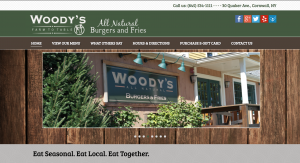It was the middle of study-week and one of my best friends was desperately trying to procrastinate. Conveniently enough for me, he had a car and I still had to go somewhere for my independent field trip!I While I have loved the farms that our class has visited throughout the semseter, I realized that I had not actually consumed any of the products produced in these farms (except for that one time in class 😉). I Googled Farm-to-Table restaurants and found that there was a burger joint in Cornwall that. My friends had always wanted to visit Storm King State Park, so when I found out that this restaurant was right next to it, we just had to go.
It was a cute restaurant, juxtaposed with the ugly and generic strip mall accross the street. The front looked like a normal house, but the back opened up to have some outdoor seating, which was great given the beautiful weather. The restaurant had a physical design that fit the general aesthetic I’ve noticed is common in these sorts of sustainability-focused projects. A muted green paint scheme complimented the hardwood floors, which gave the restaurant a very “organic” feel to it. It made me start to think about the way these sorts of farm-based institutions brand themselves. Is it necessary, I wondered, for restaurants that are farm-to-table to brand themselves in such a distinguishable way? Even their website was replete with wooden and green imagery:
“Eat seasonal. Eat Local. Eat Together.” This was also printed on a word-art poster they had hanging on their wall. Could it be possible that they are defining themselves as outside of what is normal? Perhaps they were attempting to justify their somewhat high prices ($14 for a burger, fries and drink!)

While the manager of the restaurant wasn’t working while I visited, I did get to talk to some of the waiters about what Woody’s meant to them. I had just eaten their signature “All Natural 6oz Burger.” While delicious, I can’t say that it tasted particularly unique. My perception changed, however, when Jeff (my waiter) told me that all of the meat used in the burger had been produced by co-op farms in Maine. It certainly came as a surprise to me to find out that this sort of farm-to-table operation was operating on an inter-state level. Why not just use a farm in the Hudson Valley? Jeff did not know what to say when I asked him.











